Course Learning Objectives:
-
Know the characteristics of flooring made of recycled rubber and realize the major areas suited for these floor systems.
-
Explain the environmental benefits realized by utilizing recycled rubber flooring.
-
Differentiate between various systems of rubber flooring systems, depending on their content and assembly
History:
From the early 1800’s when rubber was in its infancy in finding various uses, to today where there is a cultivated rubber tree for every two human beings, rubber plays a significant role in our lives. The U. S. alone imports half of it and synthesizes as much or more from petroleum.
Today the automobile tire is a major use of rubber, and for many years since the onslaught of the automobile in our society, the problem of disposing of rubber tires has been mounting as the number of automobiles has increased. In recent years there have been many creative ideas in recycling or disposing of automobile tires.
Process:
There are several methods of rubber tire reclamation, but for this paper we will briefly discuss the two main processing categories; namely, Mechanical Grinding at ambient conditions, and Cryogenics.
-
Mechanical Grinding - The most common process currently is well developed
-
Cryogenics. - This consists of freezing the shredded rubber (using liquid nitrogen) to extremely low temperatures, generally in a ‘freezing tube’. The frozen rubber is then very easily mechanically crushed into small particles with the fiber and steel being removed in the same way as in mechanical grinding. The advantage of this method is a cleaner, slightly faster operation resulting in the production of fine mesh sizes economically. The disadvantage is represented by the higher production cost due to the added cost of liquid nitrogen in the process.
with a variety of components available to reduce the crumb at relatively low cost. This method consists of mechanically breaking down the rubber shred into small particles using a variety of grinding techniques, such as "cracker mills", granulators, etc. The steel bead and wire mesh in the tires is magnetically separated from the crumb during the various stages of granulation and the fiber in the tire is separated by sieve shakers.
In addition to reclamation, a further method of disposing of scrap rubber is through incineration. This incineration process usually uses tires as fuel in cement kilns or steam power plants for electricity production as a blend with coal. Currently cement kilns, power plants, and paper mills burn 2"x2" rubber chips known as TDF (Tire Derived Fuel) and consume 40% of the tires generated annually. The products made with granules and crumb now utilize only 22% of the U.S. volume.
Some people believe that burning the tires (no matter how safe the practice is purported to be) wastes a valuable "natural resource".
Environmental Considerations:
Through the reclamation process, the U.S. discovered a market for the 245 million in scrap tires disposed of annually. The "reclaimed" products are used for OEM, industrial and architectural applications. The flooring industry has been one of the largest users of scrap tires in recent years. Dodge-Regupol, Inc., the sponsor of this course, processes over 2.5 million tires per year (45 million pounds). It provides designers with an inexpensive and tough surface material that withstands time and the elements. As development is being carried out, more and more applications of recycled tires and other materials are being created each day.
Environmentally, the increased usage of recycled tires is good news. Several years ago, the excess discarded tires were openly burned, polluting the atmosphere; taking up valuable space in the nation’s landfills; or, worse yet, stockpiling and collecting stagnant water becoming a breeding ground for mosquitoes. Being able to utilize this vast resource not only helps clean up the environment, but also gives the economy a boost having a direct impact on the tax base and providing jobs.
Rubber Flooring:
With the development of more rubber flooring products, the specifier can become confused by the various floor systems. Some flooring systems are made with no recycled rubber; some are made partially from recycled rubber, and some are made totally from recycled rubber. The intent of the following information will be to help clarify some of the areas of confusion.
Conventional Sheet Rubber Flooring and Tile:
The conventional sheet rubber flooring and rubber tile product is not made of recycled rubber products. This flooring product usually contains a percentage of Styrene Butadiene Rubber (SBR) and is manufactured in compliance with the International Institute of Synthetic Rubber Producers. The following are some of its main characteristics:
Benefits:
-Available in rolls and tile.
-Typically has a full thickness wear surface (3/32", 1/8"and 3/16" are a common sheet thickness)
-Resilience and high endurance level
-Logo/ Graphics available
-Dimensional stability (will not shrink during or after installation)
-Resists stains & scorch- rubber resists cigarette scorching and it provides a surface, which is highly resistant to liquids.
-Cushions foot traffic and provides skid resistant surface.
-Produces no toxic gasses during a fire.
-PVC free, asbestos free and halogen-free
Disadvantages:
-Price - It cost more to produce and to obtain some of its unique features.
-Maintenance - Scuffs easily & hard to clean.
-Installation - Hard to handle & difficult to install
Applications:
-Commercial, industrial, educational, hospital, institutional.
Recycled Rubber Flooring --Laminated or Vulcanized:
This flooring system utilizes recycled rubber mainly for the base mat for its cushion effect, and provides a laminated or vulcanized top finish coat for a wear layer. The typical system is produced in tiles, but some are available in rolls. The cushioned underlayement allows for greater walking comfort and reduces fatigue. It absorbs sound from walking and the usual noisy rolling equipment.
Following are some of its characteristics:
Benefits:
-
Available in tile and sometimes roll
-
Wear layer on top with pigmented colors
-
Resilient and durable
-
Resistant to fire and cigarette burns
-
Resistant to most stains, and liquid spills
-
Meets ADA recommendations for slip resistance (traction)
-
Graphics available
-
Good sound absorption-- quiet
-
Low maintenance
Disadvantages:
-
Wear and color limited by the wear layer thickness of laminate
-
Uneven distribution of colored chips
-
Relatively expensive (compared to solid recycled products)
-
Full of seams; difficult& expensive to install
Applications:
-
Commercial, industrial, educational, institutional, retail, and
-
Athletic areas (indoor & outdoor)
-
Golf shop and clubhouse, and weight room.
Flooring Made From 100% Recycled Rubber:
As opposed to the other rubber flooring systems previously discussed, this system does not rely on a laminate or vulcanization process to define a wear surface. Being consistent throughout, it’s wear surface is the total thickness of the item, therefore, colors will not fade or disappear on heavily traveled areas of the floor. Also, it creates slip resistance far beyond vinyl or conventional rubber flooring, which is critical when safety is paramount in your design. Made with high quality SBR (Styrene-Butadiene Rubber) tire rubber blended with pigmented EPDM rubber granulated for the addition of color.
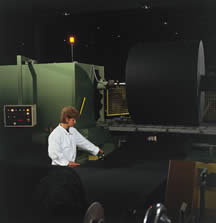
Depending on the manufacturer, there are several options when specifying this system: For example, Dodge-Regupol ECOsurface is available 1) rolls in various thickness; 2) tiles in various thickness; 3) molded rectangular or interlocking pavers for indoor or outdoor use 4) shock pad underlayment. Following are some characteristics of the 100% recycled rubber flooring:
Benefits:
-
Available in rolls, tiles and pavers – thickness 5/32",1/4",3/8", 5/8", 1-3/4"
-
Shock pad underlayment - thickness 1/2", 1"
-
Indoor/Outdoor flooring
-
Single-ply, non-laminated surface
-
Exceeds ADA recommendations for traction (DRI ECOsurfaces slip resistance = .90-1.10)
-
Consistent color throughout—no wear layer
-
Cushioned resilience
-
Excellent indoor air quality-low VOC emissions - passes the Washington state (the most stringent) indoor air quality standards
-
Graphics readily available for creativity and imagination. 
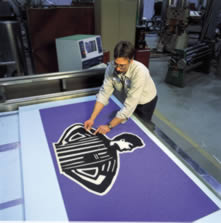
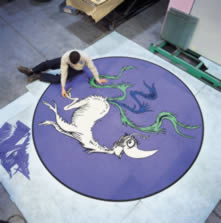
-
38 Standard colors and custom colors (available)
-
Easy installation
-
Low maintenance
NO Scuff surface
Daily/Regular Cleaning:
-
sweep, dust mop or vacuum
-
To remove stubborn dirt, damp mop or buff
-
To restore gloss - buff
Periodic Maintenance: -
Heavy scrub with a cleaning solution
-
Clean with a wet/dry vacuum
-
Low cost ranging from $3.50/SF to $6.00/SF installed!
-
Recommended floor finishing program provides either matte or glossy finish
Restoration Maintenance:
Rotary scrubber (stripping isn't necessary until there's a noticeable build-up) Wet vacuum Apply final floor finish For outdoor applications - pressure wash
Disadvantages:
-
Specifiers are often unaware of the advantages
Application:
-
Retail Stores
-
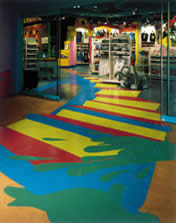
-
Corporate Center
-
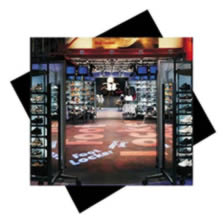

-
Academic Institutions
-
Museums
-

-
Amusement Facilities
-
Athletic Departments
-
Ice Rinks, Ski Lodges
-

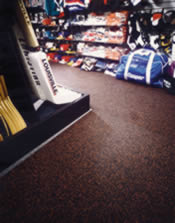
-
Golf Course Clubhouses
 |
 |
Summary:
Just as one is sometimes overwhelmed by the breadth and variations of products in the category of "Resilient Flooring", there are still wide variations in the sub-category of "Rubber Flooring". The above discussion was developed in hopes of clarifying some of these areas, and perhaps, germinate some environmental issues for enacting pro-active initiatives with regard to manufactured products utilizing recycled materials.
End of Course: